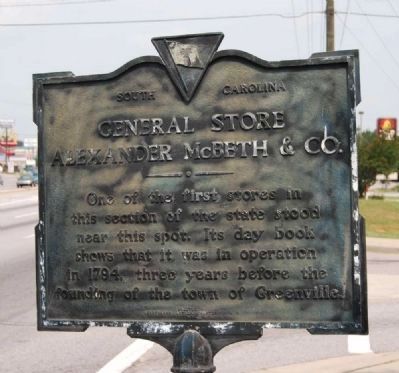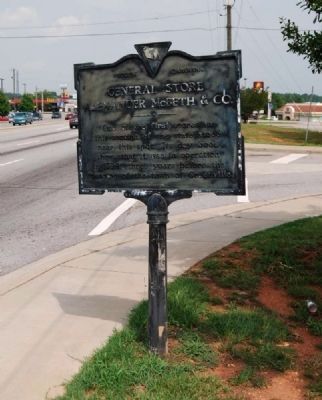Greenville in Greenville County, South Carolina — The American South (South Atlantic)
General Store
Alexander McBeth & Co.
One of the first stores in this section of the state stood near this spot. Its day book shows that it was in operation in 1794, three years before the founding of the town of Greenville.
Erected 1956 by Behethland Chapter, Daughters of the American Revolution. (Marker Number 23-5.)
Topics and series. This historical marker is listed in this topic list: Industry & Commerce. In addition, it is included in the Daughters of the American Revolution series list. A significant historical year for this entry is 1794.
Location. 34° 51.071′ N, 82° 27.022′ W. Marker is in Greenville, South Carolina, in Greenville County. Marker is at the intersection of White Horse Road (U.S. 25) and Banner Drive, on the right when traveling north on White Horse Road. Touch for map. Marker is in this post office area: Greenville SC 29611, United States of America. Touch for directions.
Other nearby markers. At least 10 other markers are within 2 miles of this marker, measured as the crow flies. Woodside Mill (approx. 1.2 miles away); Dr. Harold B. Sightler (approx. 1˝ miles away); Parker High School Auditorium (approx. 1˝ miles away); Brandon Mill (approx. 1.7 miles away); Woodside (approx. 1.7 miles away); Mills Mill (approx. 1.7 miles away); Monaghan (approx. 1.7 miles away); Union Bleachery (approx. 1.7 miles away); Piedmont (approx. 1.7 miles away); Dunean (approx. 1.7 miles away). Touch for a list and map of all markers in Greenville.
More about this marker. True to its heritage, the location is now home to a strip-mall.
Additional commentary.
1. McBeth's Store on the White Horse Road
The growing importance of the central area of the county was indicated by the opening of a second store in Greenville County, in addition to Richard Harrison's. The new store was operated by Alexander McBeth, and it opened prior to January 1794, at least a year before the occupation of the second courthouse. McBeth was a wealthy landowner in Union County who had operated a mercantile business there since December 17893 Concurrently with his expansion into Greenville, he opened another branch of Alexander McBeth & company in Spartanburg County. In Greenville he leased 8 acres west of the reedy River from John Blassingame, whose father was sheriff of Union County, at the point where the Island Ford Road, once Pearis's Wagon Road, crossed the White Horse Road. It was a major intersection between two important thoroughfares. McBeth's store was a frame structure, 30 feet by 18 feet, roofed with shingles.
For four months -- from January to April 1794 -- McBeth recorded his transactions in a day book which still survives. His clientele came from a wide geographic area, including Waddy Thompson and James Williams in Pendleton County and Baylis Earle in Spartanburg County. Thompson purchased household goods such as paper, pins, ribbon, and shoes and osnaburgs to clothe his slaves. Lemuel Alston bought a punch bowl, three small mugs, a large glass tumbler, six tablespoons, ribbon, a pocket handkerchief, and two nutmegs. John Blassingame purchased a looking glass, a blue teapot, and six earthenware plates. By far the most common purchase was a half-pint of whiskey for 7s 6p. A number of McBeth's customers purchased almanacs at the beginning of the new year, and William Jarvis bought a copy of the New Testament.
McBeth secured goods from Charleston, and with little coinage in circulation, he took in exchange for purchases a large number of deerskins, pork, tallow, beeswax, whiskey, corn, wheat, and cotton. besides the customary retail and banking services, he provided blacksmithing as well. In addition, he purchased a still from Charleston with which he may have stocked his store with whiskey. (Source: Greenville: The History of the City and County in the South Carolina Piedmont by Archie Vernon Huff (1995), pg 57.)
— Submitted September 13, 2009, by Brian Scott of Anderson, South Carolina.
Credits. This page was last revised on November 16, 2020. It was originally submitted on July 13, 2008, by Brian Scott of Anderson, South Carolina. This page has been viewed 1,904 times since then and 36 times this year. Photos: 1, 2. submitted on September 13, 2009, by Brian Scott of Anderson, South Carolina. • Kevin W. was the editor who published this page.

